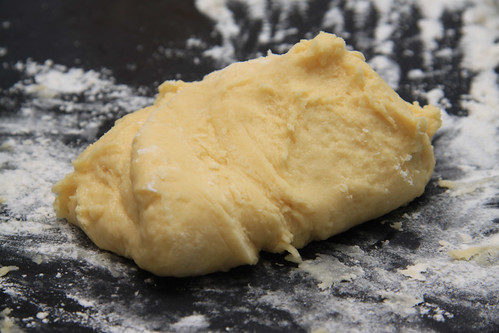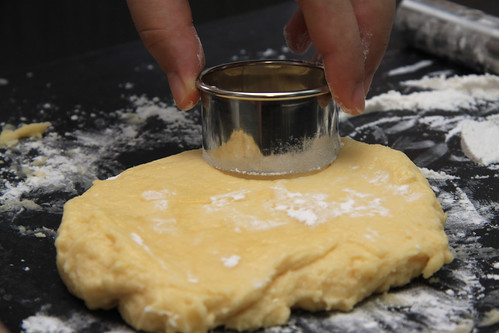
Having searched through the net and youtube, some of the recipes gives very crumbly texture while some provides the cake-like, moist texture which Fen likes.
I started with a recipe that uses a lot of sugar with an additional yolk and the resulting factor was what Fen describes as a delicious rock bun. After which, I attempt with another recipe that uses sour cream and instead of mixing it, I whisk it, giving a texture that is similar to a coarse pound cake. Since Fen finds my scones too sweet to her liking, I made one without sugar and that was disastrous, it was incredibly salty. That was when I decided to look for help on youtube. After fixing the composition of flour, sugar, baking powder and butter, it seems that the variables to play with are the wet ingredients, namely the egg and in this case, I used the Meiji Low Fat Milk since I have weird tasting scones after using cream and sour cream and after 3 more attempts, I finally got it...

Here are the parameters I have changed and I have added my personal observations for reference.
- Baking powder, I started off with 1.5 tbsp baking powder (likely to be a typo in that recipe) and it has a strong aftertaste so either you use self-raising flour or 1 cup plain flour (120gm) with 1 teaspoon baking powder
- Egg, omitting this ingredient will give you a crumbly texture (that you cannot even hold the scones with your fingers, it just breaks apart). Ultimately, egg is a binder in baking
- Milk, the ingredient that makes the scones moist; however, we add this ingredient by teaspoon. If the mixture is too wet, reduce by a teaspoon, if the mixture is too dry, increase by a teaspoon. The resulting dough should be good enough to knead and not extremely sticky.

- Kneading the dough makes it moist and chewy while omitting this step results in a crumbly texture (depend on individual's preference). I made this conclusion as my 6th attempt involves in splitting my dough into 2 portions, with only one portion kneaded.

- Chilling the scones prior baking at 200°C, seems to allow the butter to harden a little before "shearing" it, this step seems to keep the scones in shape rather than flattening to look like a cookie. I started chilling them after my 3rd attempt and since then, they remain in shape. It could also be due to the oven temperature as prior to my 3rd attempt, the bakings were done at 180°C.

- Cooling the scones by sandwiching with a clean cloth, seems to retain the moisture of the scones. At least, this is what we see in most youtube recipes.
Recipe (For five to six 5-cm scones)
Ingredients needed:
1 cup (120 gm) plain flour
1/8 cup (40 gm) granulated white sugar
1 teaspoon baking powder
50 gm salted butter
1 beaten egg (approximately 50 gm)
25ml Low Fat Meiji Milk (approximately 5 teaspoon)
Steps
1. In a large bowl, add flour, sugar and baking powder.
2. Rub in the butter into dry ingredients until coarse crumbs is obtained.
3. Stir in beaten egg (leave some for glazing).
4. Add milk and stir to combine (see above notes).
5. Transfer to a lightly floured surface and knead the dough gently four to five times.
6. Using a lightly floured round pastry cutter and cut the dough into rounds.
7. Place the rounds on baking pan (either greased or lined with baking sheet).
8. Brush the tops of the scones with beaten egg (Optional: egg/milk mixture can be used).
9. Chill the scones in the refrigerator for an hour.
10. Bake for 12 minutes at 200°C.
- Ending Note –
I think the most important step is when adding the wet ingredients. I.e. Egg and milk. If we exclude eggs, it will be coarse and breaks easily. As for milk, just add enough for you to knead. if it is too wet, there is no way you can knead and the scone will not stay in shape. It will probably sink and look like a cookie.


1 comments:
Hi,
Nice post on scone making you have there.
I don't really have much experience making scones but my best attempt with scones was with whipping cream and european butter and it tasted really good (a bit similar to popeyes chicken's and texas chicken's)! The dough was very wet though but it is not an issue since I always have the habit of chilling the dough until really firm, which for me is a must since our weather here is really quite unkind to pastry doughs and cookie doughs (actually I freeze my dough so that they firm up much faster).
Those cream scones turn out crusty on the exterior and ultra light and cakey on the interior as I worked the dough to a minimum (I did not even knead, hence little gluten formation). They were flavourful enough to be eaten on their own too.
Personally, I tend to use more European butters these days. They tend to be off-white in colour and you can really smell the fragrance from the butter. Emborg, President, Elle & Vire and Lurpak are all quite good.
On a side note, scones taste awesome with homemade jam too.
Post a Comment